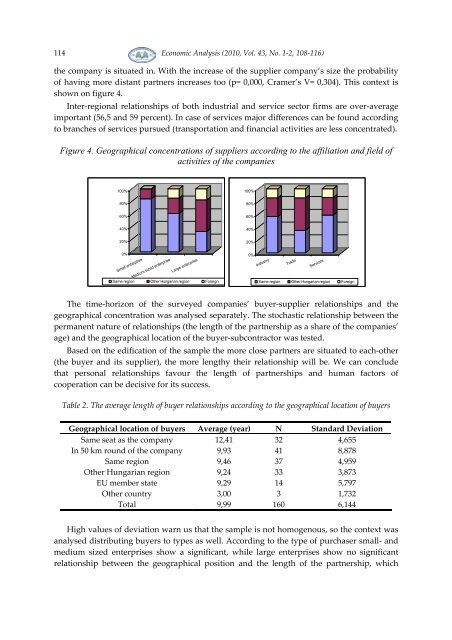Twice a Year Scientific Journal
Twice a Year Scientific Journal
Twice a Year Scientific Journal
You also want an ePaper? Increase the reach of your titles
YUMPU automatically turns print PDFs into web optimized ePapers that Google loves.
114<br />
Economic Analysis (2010, Vol. 43, No. 1-2, 108-116)<br />
the company is situated in. With the increase of the supplier company’s size the probability<br />
of having more distant partners increases too (p= 0,000, Cramer’s V= 0,304). This context is<br />
shown on figure 4.<br />
Inter-regional relationships of both industrial and service sector firms are over-average<br />
important (56,5 and 59 percent). In case of services major differences can be found according<br />
to branches of services pursued (transportation and financial activities are less concentrated).<br />
Figure 4. Geographical concentrations of suppliers according to the affiliation and field of<br />
activities of the companies<br />
100%<br />
100%<br />
80%<br />
80%<br />
60%<br />
60%<br />
40%<br />
40%<br />
20%<br />
20%<br />
0%<br />
Small enterptise<br />
Medium sized enterprise<br />
Large enterprise<br />
Same region Other Hungarian region Foreign<br />
0%<br />
Industry<br />
Trade<br />
Services<br />
Same region Other Hungarian region Foreign<br />
The time-horizon of the surveyed companies’ buyer-supplier relationships and the<br />
geographical concentration was analysed separately. The stochastic relationship between the<br />
permanent nature of relationships (the length of the partnership as a share of the companies’<br />
age) and the geographical location of the buyer-subcontractor was tested.<br />
Based on the edification of the sample the more close partners are situated to each-other<br />
(the buyer and its supplier), the more lengthy their relationship will be. We can conclude<br />
that personal relationships favour the length of partnerships and human factors of<br />
cooperation can be decisive for its success.<br />
Table 2. The average length of buyer relationships according to the geographical location of buyers<br />
Geographical location of buyers Average (year) N Standard Deviation<br />
Same seat as the company 12,41 32 4,655<br />
In 50 km round of the company 9,93 41 8,878<br />
Same region 9,46 37 4,959<br />
Other Hungarian region 9,24 33 3,873<br />
EU member state 9,29 14 5,797<br />
Other country 3,00 3 1,732<br />
Total 9,99 160 6,144<br />
High values of deviation warn us that the sample is not homogenous, so the context was<br />
analysed distributing buyers to types as well. According to the type of purchaser small- and<br />
medium sized enterprises show a significant, while large enterprises show no significant<br />
relationship between the geographical position and the length of the partnership, which
















